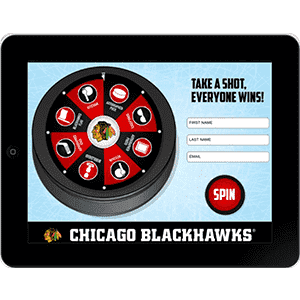NFC technology, Near Field Communications offers serious new mobile marketing avenues to engage players with Brands via mobile marketing games. It won’t be long until you will be using NFC on your smartphone on a daily basis, it will be a part of your daily life.
Engage consumers at the point of sale, on retail related marketing materials for coupon distribution, Prizes, Surveys, Reviews, Menus, Posters, & Products. The chance to win a prize has always been the greatest incentive to engage a consumer. Brand Gaming offers NFC Marketing Games
Before long, you will be using NFC on your smartphone on a daily basis, without even realizing it.
This video explains how NFC and our NFC Marketing Games can improve your marketing initiatives
Using NfC Technology, Near Field Communications For Interactive Games
It is a standard for devices that communicate at close range. It is used as an alternative to Bluetooth when two devices share information, such as transferring contact information from one phone to another. NFC is also used in certain social media applications and multiplayer games when players are close to each other.
It’s a subset of a technology called RFID, so let’s dig a little deeper into RFID and go back to NFC. Radio frequency identification (RFID) is a generic term for a technology that uses radio waves and readers to monitor specific tags. RFID is one of the oldest technologies that uses magnetic field communication.
NFC is a short-range, half-duplex communication technology that facilitates secure communication between devices in the field region. Near-field communication is a technology that allows two devices to exchange information at close range. Near Field Communication (NFC) is a spectrum of short-range wireless technologies that require a distance of 4 cm or less to establish a connection.
NFC (Near Field Communication) is a standard-based short-range wireless communications technology that allows interaction between electronic devices. It developed from RFID (Radio Frequency Identification) technology, which was developed in the 1990s. Currently, NFC is used for contactless communication between handsets and devices.
This technology enables wireless communication between intelligent NFC devices and NFC-enabled objects. NFC technology is a semi-duplex short-range communication developed in late 2002 by Philips and Sony for contactless communication. It is based on the principle of inductive coupling between transmitter and receiver, which differs from the remote field communication (RF) used for long-range wireless applications.
The strength of NFC technology lies in its ease of use, which triggers communication with a simple touch over a short distance and terminates communication when the device is detached. One of the most important aspects of NFC is its inherent security, as the communication range is very short. Due to its availability in smartphones, NFC offers untapped potential for a variety of different applications.
In the field of game-based learning, it was tested as part of research on N2- Near Field Communication (NFC) in educational areas and its operations capabilities. Phones are capable of transferring data, contacts and photos between two devices via NFC as soon as you touch them. NFC enables two-way communication in contrast to RFID, which is a one-way communication between a reader and a tag.
At a high level of integration, NFC technology is a strength point that enables interactions with the existing RFID infrastructure. NFC devices can exchange data with existing card readers and ISO 14443 compliant devices, such as other NFC mobile phones. The NFC technology mentioned above is directly related to mobile communication, but the possibilities extend to the use of mobile devices as payment terminals.
Last year, Visa teamed up with the NFL and the San Francisco 49ers to provide 700 NFC-enabled point-of-sale terminals at Levis Stadium, the site of Super Bowl 50, allowing cardholders to pay with a smartphone to buy groceries, drinks and goods during the game. In England, Gemalto introduced NFC tapes for Saracens, the superstar rugby team, to improve the fan experience on match days. For the first time, with NFC technology you can find contactless reward cards like Walgreens Balance Rewards and Apple Pay which can be used as rewards cards or store prepaid cards – a great move that uses NFC to save baseball fans a lot of time.
The NBA (National Basketball Association) has taken a big step toward improving the fan experience in 2017 by courting fans with the release of new official NBA uniforms. In museums today, all kinds of technologies are able to merge the real experience of the visitor with improved information in a virtual world. In many of the world’s leading museums, systems such as QR codes and augmented reality where visitors from their smart devices can access additional content in the virtual world are not uncommon.
Few of us could have imagined that the new world of the Internet of Things would merge video and mobile games with the physical world and that the use of popular toys would be an integral part of the video or mobile gaming experience. In August, Nintendo said the game was one of the top three titles of the year in North America and Europe and Topell Action Figures in the United States for the first half of 2012, enabling long-range wireless technology to unite devices for the exchange of data. The NFC technology opens worlds for children of all ages and bridges the gap between physical and virtual games. In addition to NFC gaming systems, NFC on mobile phones enables interaction with other objects in the real world.
Organizations can invite players to use NFC mobile devices to search their surroundings for clues to win games and contests. NFC technology is not designed to process large amounts of information, so the amount of data that can be transmitted is not significant. Personal information, credit cards and sensitive data stored on NFC devices can be targeted by hackers and cybercriminals. However, NFC technology is omnipresent in our lives, as many devices in the US implement standard access management systems for mobile phones in our offices.
Payments, access to websites visited and any information collected and monitored by NFC devices are associated with our identity. Apps that have to be installed on NFC devices (smartphones, smart watches) need NFC tags (e.g. Apple Pay, Google Pay, etc.). For payments. Specific tags include antennas and tiny chips that come in many shapes and sizes.
Tolls for highways and plastic items such as clothing and other expensive items in shops are common examples of RFID tags. Data transmission with NFC technology is based on magnetic flux, the strength of which is proportional to the square distance between the NFC device and the tag antenna. Nevertheless, NFC tags do not work so well with smart devices that take visitors to museums.
As the magnetic flux decreases the distance between the NFC device and the tag antenna (or tag antenna) increases, limiting the range and effectiveness of the NFC technology to a few centimeters. Despite the
growth of NFC products on the market, individual manufacturers have still not implemented the technology.
Check out our Available Branded Game Marketing Instant Win Games
Virtual Prize Wheel, Virtual Scratch Off, Virtual Golf, Slot Machine, Plinko, Dice, Choose One, Virtual Bingo, Memory Match and Custom Instant Win Games.

